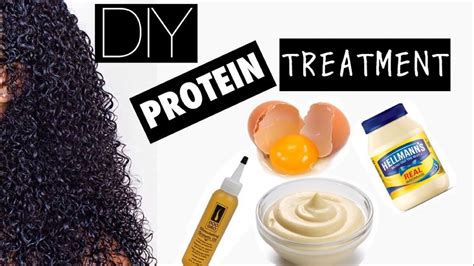Introduction
Your hair is a crucial part of your overall appearance, and its health and vitality are often a reflection of your general well-being. One essential aspect of hair care is protein treatment, which can help strengthen, repair, and protect your locks.

What is a Hair Care Protein Treatment?
A hair care protein treatment is a specialized treatment that involves applying a protein solution to the hair. This solution can be derived from various sources, such as keratin, collagen, or soy. When applied to the hair, these proteins bond to the hair shaft, reinforcing its structure.
Benefits of Hair Care Protein Treatments
Protein treatments offer numerous benefits for your hair, including:
- Strengthening: Protein strengthens the hair shaft, reducing breakage and split ends. It helps improve hair elasticity and makes it more resistant to damage from styling, heat, and environmental factors.
- Repairing: Proteins play a crucial role in repairing damaged hair. They fill in weak spots in the hair shaft, smoothing the cuticle, and restoring the hair’s natural strength and integrity.
- Protecting: Protein treatments create a protective barrier on the hair, shielding it from external aggressors such as heat, UV radiation, and pollution. This helps prevent further damage and maintains the hair’s health.
- Improving Moisture Retention: Proteins help hair retain moisture, preventing it from becoming dry, brittle, and prone to breakage. They promote hydration and give hair a soft, supple look and feel.
- Smoothing: Protein treatments can help smooth rough cuticles, reducing frizz and promoting a more polished and manageable appearance.
Types of Hair Care Protein Treatments
There are several types of hair care protein treatments available, each with its unique benefits:
| Treatment Type | Description |
|---|---|
| Keratin Treatment | Keratin is a natural protein found in hair. Keratin treatments use a concentrated keratin solution to replenish the hair’s keratin content, resulting in smoother, straighter, and more manageable hair. |
| Collagen Treatment | Collagen is another natural protein that supports the structure of the hair. Collagen treatments strengthen the hair shaft, improve elasticity, and reduce signs of aging. |
| Soy Treatment | Soy protein is a plant-based protein that provides moisture and strength to the hair. Soy treatments are ideal for fine, damaged, or color-treated hair. |
How to Choose the Right Hair Care Protein Treatment
The best hair care protein treatment for you depends on your specific hair type and needs. Consider the following factors when choosing a treatment:
- Hair Type: Fine hair may benefit from lighter protein treatments, while thicker, coarser hair requires more intense treatments.
- Hair Condition: Damaged hair or hair prone to breakage will benefit from more restorative treatments.
- Hair Goals: If you want smoother, straighter hair, a keratin treatment may be a good option. For stronger, more resilient hair, consider a collagen or soy treatment.
Step-by-Step Guide to Applying a Hair Care Protein Treatment
Follow these steps to apply a protein treatment at home:
- Wash and Condition: Wash your hair with a clarifying shampoo and conditioner to remove any dirt or product buildup.
- Apply Treatment: Apply the protein treatment evenly to damp hair, working from the roots to the tips. Use a wide-toothed comb to distribute the product and ensure thorough coverage.
- Leave In: Leave the treatment in for the specified amount of time as per the manufacturer’s instructions. Typically, treatments require 15-30 minutes.
- Rinse: Rinse the treatment thoroughly with lukewarm water to remove any excess product.
- Blow Dry: Blow dry your hair on a low heat setting to activate the protein and enhance its effects.
- Style: Style your hair as desired.
How Often to Get a Hair Care Protein Treatment
The frequency of protein treatments depends on your hair type and needs. As a general rule:
- Damaged or Over-Processed Hair: Once a week or more often if needed.
- Healthy Hair: Once every 2-4 weeks.
- Fine Hair: Once a month or less often.
Overuse of Protein Treatments
While protein treatments are beneficial, overusing them can also damage your hair. Too much protein can lead to:
- Stiffness: Overly proteined hair can become stiff and difficult to style.
- Brittleness: Excess protein can dry out the hair, making it prone to breakage and split ends.
- Protein Overload: This occurs when hair becomes saturated with protein, causing it to lose its natural elasticity and become susceptible to damage.
FAQs about Hair Care Protein Treatments
-
Can protein treatments be used on all hair types?
– Yes, protein treatments can benefit all hair types, but the type of protein and the frequency of treatments may vary. -
How long do the effects of a protein treatment last?
– The effects of a protein treatment can last for 2-4 weeks, depending on the type of treatment and hair care practices. -
Can I color my hair after a protein treatment?
– Yes, but it’s recommended to wait 2-3 days after the protein treatment to allow the hair cuticle to close fully. -
How do I know if my hair needs a protein treatment?
– Signs of hair that needs a protein treatment include breakage, split ends, dry hair, and dullness. -
Can I get a protein treatment at home?
– Yes, various at-home protein treatment kits are available. However, always follow the manufacturer’s instructions carefully. -
Is it safe to use a protein treatment during pregnancy or breastfeeding?
– Consult your healthcare provider before undergoing any hair treatments during pregnancy or breastfeeding. -
Can protein treatments damage my hair?
– Yes, overusing protein treatments can damage hair. Stick to the recommended frequency and avoid multiple treatments in a short period. -
How can I avoid protein overload?
– Monitor your hair’s condition and adjust the frequency of your protein treatments accordingly. If your hair becomes stiff or brittle, reduce the frequency or switch to a less intensive treatment.
